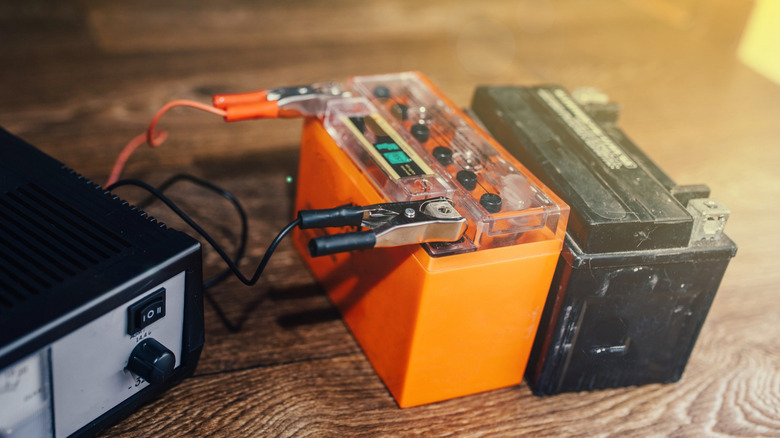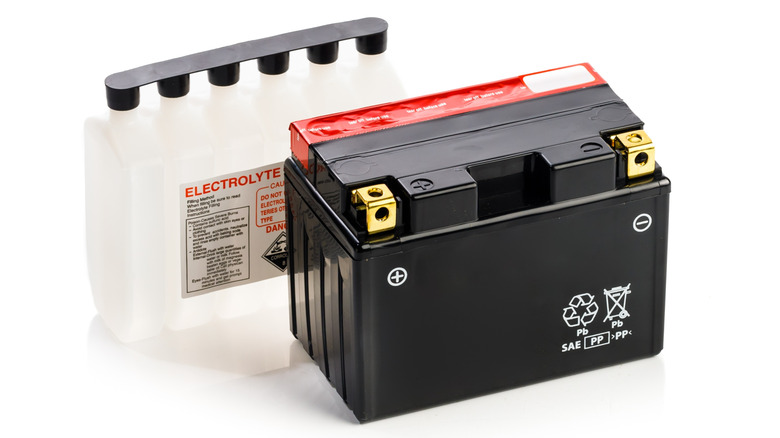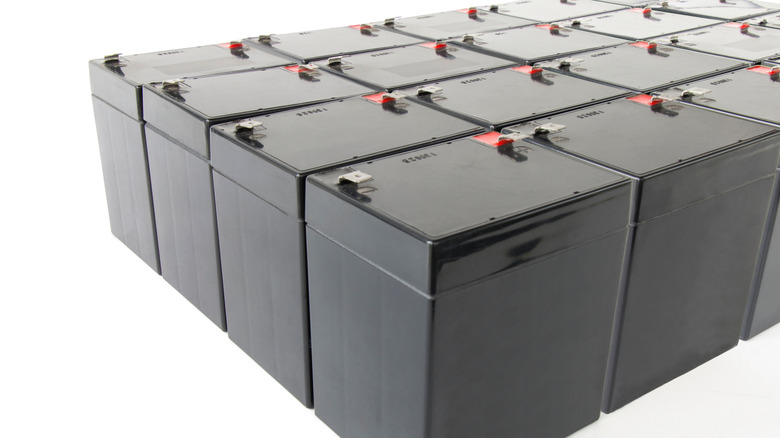The TSA Allows Non-Spillable Wet Batteries On A Flight, But What Are They?
One of the trickiest parts about flight travel, especially overseas, is the conundrum over what items to carry and which ones to avoid. The situation is particularly confusing when it comes to electronics, which use different kinds of batteries with their unique chemistry and risk profiles. Among them are the rather curious bunch of non-spillable batteries, which are deemed safe for air travel by the Transportation Security Administration (TSA). The travel safety agency says you can take gadgets with non-spillable batteries in your carry bags and checked-in luggage, too.
But what exactly are they? Broadly speaking, the electrochemical content of such batteries doesn't spill, which means the package doesn't contain any liquid, or a very small amount of it. The battery liquid, technically known as an electrolyte, can either be acid (such as sulfuric acid) or an alkaline chemical. It is a crucial component because the liquid acts as the conducting material that allows movement of ions within the package, leading to the production of an electric current.
In a non-spillable battery, the liquid electrolyte is replaced by a gel or a solid component. The core idea is to ensure that the corrosive electrolyte inside a battery doesn't spill over due to any accident or blunt force exposure. Due to the absence of liquid electrolytes, non-spillable batteries do not pose any of the usual fire, burn, and gas poisoning hazards. The TSA, however, warns that only non-spillable batteries within the 12V voltage and 100 watt hours rating are allowed.
What qualifies as a non-spillable battery?
Every battery that is devoid of a liquid electrolyte doesn't automatically classify as a non-spillable battery. There are strict rules that govern the classification of batteries as such. As per the United Nations' International Civil Aviation Organization (ICAO), a battery can be labeled as non-spillable if the internal material can survive rupture or physical damage at a temperature of 131 degrees Fahrenheit (or 55 degrees Celsius) without any material flow. "The battery must not contain any free or unabsorbed liquid," adds the rulebook.
Aside from temperature, the battery must also pass vibration and pressure differential tests to qualify as non-spillable. As part of the Dangerous Goods Regulations followed by the International Air Transport Association (IATA), wet cell batteries can technically be classified as non-spillable if they pass the aforementioned temperature, vibration, and pressure tests as part of the Special Provision A67.
So, what's the core reason behind allowing non-spillable batteries? The main objective is to avoid instances of short circuit that could happen due to damage to the internal components an unintended activation. There are also strict rules for the external packaging of such spill-proof batteries. "Batteries must be protected against short circuits and must be securely packed in strong outer packagings," says the package UN agency's package guideline. After passing the tests, they are officially labeled as "Batteries, wet, non-spillable" under the "UN 2800" provision code. This labeling and the underlying tests are followed for package delivery by road, railway, sea, and air transport.
What's special about non-spillable batteries?
According to the IATA, a non-spillable battery must have an "absorbed electrolyte (absorbed glass mat (AGM), gel battery, gel cell, sealed lead-acid (SLS), dry and dry cell) and do not leak any electrolyte or liquid even if the battery case is ruptured or cracked." Non-spillable batteries that are acceptable for air travel are often found fitted inside items such as toys, power tools, two-wheelers, and accessibility mobile vehicles. Aside from regulated transport mediums, these rules are also followed by commercial delivery services such as UPS.
Commercially, non-spillable batteries go by names such as valve-regulated lead-acid (VRLA) or sealed lead-acid (SLA) batteries. VRLA batteries, in turn, are available in different formats, depending on whether they utilize an absorbent glass mat (AGM) or gel cell. Take, for example, HP, which sources non-spillable VLRA batteries from a brand named Yuasa for its computing products. These batteries contain a very small quantity of battery acid and utilize a pressure relief valve as a safety measure. Even when these batteries are inverted, no liquid spill happens.
Aside from electronics, these batteries are also used in emergency lighting solutions, computer backup power units, and solar power kits. Then we have absorbed glass mat (AGM) batteries, which use glass sheets for storing the electrolyte. In such batteries, hydrogen and oxygen molecules combine in a sealed package, allowing them to be mounted vertically or horizontally without any leak or spill risks. In gel-based batteries, the electrolyte is mixed with silicon dioxide and a jelly-like thickening agent, which essentially creates a gel-like immobile medium for ion movement.


